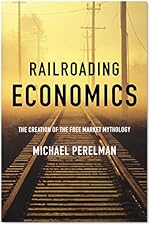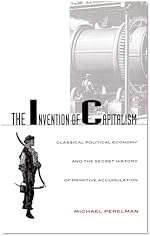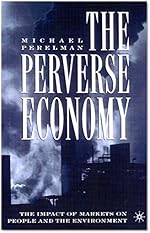Archive for October, 2007|Monthly archive page
Introduction to My New Book in Progress
Now that the Confiscation of American Prosperity has been published, I have a new book that is fairly well advanced. I expect that , The Manacles of Capitalism: How Market Control Undermines Productivity, I will have the manuscript ready to send to Stanford University Press in a few months.
Here is my introduction. Any suggestions would be appreciated. Most of all, my title is clunky. Anyone who comes up with a title that works for me, will win a free copy of the book. Continue reading
Globalization — A New Twist
I just spent the weekend with a pretty high level delegation from China. At the final banquet, some of them were telling my wife that they appreciated the low prices in US stores. They were especially happy with some shoes that cost 6 times more than in China. They were taken aback when she mentioned that the shoes were made in China, where they presumably cost far less than in Los Angeles.
Wal-Mart’s Efficiency — In Avoiding Taxes!
This Wall Street Journal article describes how Wal-Mart is able to pay about half as much state tax as a typical corporation.
Drucker, Jesse. 2007. “Inside Wal-Mart’s Bid To Slash State Taxes.” Wall Street Journal (23 October): p. A 1.
“In May 2001, Wal-Mart Stores Inc. issued an appeal to big accounting firms: Find us creative new ways to cut our state tax bills. Ernst & Young LLP swung into action. Senior tax experts at the big accounting firm swapped ideas via email and in a series of meetings. At least one gathering, according to an internal Ernst & Young calendar, took place in Wal-Mart’s headquarters in the “Tax Shelter Room”.” Continue reading
Book Announcement
MORE UNEQUAL: ASPECTS OF CLASS IN THE UNITED STATES
Monthly Review Press Edited by Michael D. Yates
With contributions by John Bellamy Foster, Vincent Navarro, William K. Tabb, Michael Perelman, Richard D. Vogel, David Roediger, Kristen Lavelle and Joe Feagin, Sabiyha Prince, Martha Gimenez, Stephanie Luce and Mark Brenner, Peter McLaren and Ramin Farahmandpur, Michael D. Yates, Angela Jancius, and Michael Zweig.
“Workers in the United States are systematically being allocated a shrinking share of the prodigious wealth we produce, and that’s old news. This widening exploitation of workers and communities further exposes the myth of a ‘just’ capitalist economy. Despite the radical increase in economic and social inequality, we still lack a cohesive popular understanding and consciousness of why and how our market-based economic system facilitates this ‘one-sided class war’ against us. Continue reading
Rich and Poor Multipliers Again
Earlier I asked about the multipliers for the consumption of rich and poor people. Let me be a little bit and more explicit. I would assume that rich people spend a lot more on personal services and expensive goods.
Expensive goods tend to have much higher markups. Remember Henry Ford II responding to the influx of Volkswagens observing that mini cars mean mini profits. Expensive branded goods have very high markups, meaning relatively few jobs per dollar of expenditure compared to the spending of the less affluent. Personal services are probably bimodal. Some professional work would probably mean relatively few jobs per dollar of expenditure; some less prestigious work might mean quite a few jobs per dollar of expenditure; for example, underpaid immigrant nannies. Any thoughts?
The Economic Benefits of the Trickle-up?
The Wall Street Journal suggests that the economy might not be affected by the credit crunch because it will mostly hit the poor. Since the poor don’t spend that much, the economy can happily sail along. I was wondering how multipliers might differ by income class.
Patterson, Scott. 2007. “Has the Crunch Filtered Down to Consumers?” Wall Street Journal (18 October): p. C 1.
“Dean Maki, an economist at Barclays Capital, expects households to muddle through even as lenders get more strict. He says many of these credit problems have hit lower-income consumers, while wealthier spenders remain largely unscathed. Roughly half of consumer spending comes from the top 20% of the income bracket, Mr. Maki says.”
Schumpeter, War, and the Woeful Deficiency Of Economic Theory
Was Schumpeter correct when he wrote: “Economics is a very unsatisfactory science. But it would have to be much more unsatisfactory than it is if such an event as a war, however extensive and destructive, sufficed to upset its teaching.”
Schumpeter, Joseph A. 1954. History of Economic Analysis (NY: Oxford University Press): p. 1146
During all-out wars when a country’s very existence is at stake, only the most foolish leader would rely on markets to run the economy. Also, during wartime, many people (excluding corporate executives?) respond to nonmarket incentives, allowing the economy to produce much more than conventional economic theory would predict.
Here is a short section from my book, Transcending the Economy:
Earlier, we discussed how economies cast aside the market when society mobilizes for war. People too behave differently during wars. Rather than performing work in a perfunctory manner, many people redouble their efforts on the job in order to contribute to the mobilization.
I do not deny that many people are unmoved by patriotic fervor. Nor would I suggest that wartime profiteering is unknown. The point is that such individualistic motives recede during times of war, while more socially-oriented behavior becomes more common.
People even leave traces of this changed motivation in the statistical residue of the times. For example, Robert Lucas, a conservative economist who won the Nobel Prize in Economics for his work in developing techniques that cast doubt on the effectiveness of government policy, estimated the average level of economic efficiency for the United States economy by calculating the trend of the ratio of output per unit of capital between 1890 and 1954. He found that, at times, for instance during depressions, the actual output per unit of capital fell below his trend line. At other times, the actual output per unit of capital exceeded the trend line.
Lucas discovered that during the war years, 1944 through 1946, the output per unit of capital surpassed the trend line by more than 20 percent. At no time, before or after, did the United States economy match this remarkable performance (Lucas 1970, p. 154).
This achievement is extraordinary because during this period, many of the most qualified workers were in the military rather than on the shop floor. The workers who replaced them had considerably less work experience. Because of decades of discrimination, the black workers who came from the South to work in Northern factories had far less education than the workers that they replaced. Similarly, many women without much experience in working for wages effectively “manned” the assembly lines.
Conventional economic theory suggests that industrial efficiency should have suffered dire consequences from this reliance on a supposedly less qualified labor force, yet Lucas shows that nothing of the sort happened. Instead, productivity soared.
Of course, we are accustomed to expecting productivity to increase during war time. War stimulates demand, which makes the economy work more efficiently. In addition, Lucas himself attributes some of the marvelous performance of the wartime economy to the use of overtime in industry.
While increased demand and overtime may have been a factor in stimulating the economy, emotional forces were also at work. War can make people pull together. War can create a sense of urgency. At times, powerful ideals can motivate working during times of war.
In the United States, World War II called forth just such a sense of idealism. People who labored in the factories in the United States during the war often did their best in order to contribute to the struggle against fascism. Such ideals were more compelling than greed for most workers.
Casey B. Mulligan, a colleague of Lucas’s at the University of Chicago, found further statistical evidence suggesting the influence of ideals (Mulligan 1998). According to economic theory, only changes in monetary incentives can change behavior. When wages fall, work effort should shrink accordingly.
He found that roughly ten million more civilians were employed during the war than if employment had followed its prewar trend (Mulligan 1998, p. 1040), even though “after-tax real wages of manufacturing production workers were lower in absolute terms (and even lower relative to trend) during the war years 1942-1945 than in the few years immediately preceding and following the war” (p. 1044). Mulligan reported on his efforts to attempt to develop alternative explanations within the confines of standard economic theory to interpret this bulge in employment even though real after-tax wages were falling. In every case he failed, suggesting that patriotic idealism lay behind the rise in labor force participation. In other words, more people were working than would be expected based merely on the desire to earn more wages. Instead, people were coming into the labor force to contribute to the war effort.
Eventually, the patriotic consensus frayed around the edges. Workers became frustrated seeing their sacrifices unmatched by their employers who were enjoying unparalleled profits. As a result, toward the end of the war, strike activity began to pick up. Still, the spirit of community was sufficiently strong to produce the high levels of productivity that caught the attention of Robert Lucas.
Similarly, Israel mobilized 15 percent of its labor force for the Yom Kippur War, but the Gross National Product declined only 5 percent (Maital 1982, p. 114). The decline in production might not seem to be as impressive as the experience of the United States, but remember the United States had time to adjust to the wartime demands, while the Yom Kippur War was a brief affair.
The wartime experiences of Japan and Germany offer even more powerful illustrations of the ability of people to overcome adversity. Jack Hirshleifer, an economist from the University of California at Los Angeles, reported that ten days of bombing raids during July and August 1943 destroyed half the buildings in Hamburg. Yet, within five months the city had regained up to 80 percent of its productive capacity (Hirshleifer 1987, pp. 32-33). The United States government was interested to find out what determined the effectiveness of the Allied bombing attacks. John Kenneth Galbraith, the famous Harvard University economist, assembled a team that included some of the most prominent economists in the world. These researchers found that bombing only made the Germans more resolute. According to the findings of the survey, “the air raids of 1943-4 … may have kept up the tension of national danger, and created the requisite atmosphere for sacrifice” (cited in Galbraith 1994, p. 131; see also Galbraith 1981, p. 205; and Scitovsky 1991, p. 258).
On August 6, 1945, the United States Air Force dropped an atomic bomb on Hiroshima. The next day, electric power service was restored to surviving areas. One week later, telephone service restarted ((Hirshleifer 1987, p. 34).
No doubt the Germans and the Japanese, like their counterparts in the United States, worked overtime to rebuild their economic capacity, but even trebling the average work day would not have sufficed to accomplish what they did. Their success in reconstructing their economy required enormous creativity and ingenuity.
We also see a more intensive development of new technologies during periods of crisis. Ordinarily, the typical large corporation is timid about exploring new ideas, yet the same people, who typically display little creativity within the confines of the large corporations, are more inclined to promote great scientific breakthroughs under the urgency of war.
Based on his reading of Japanese history, Shigeto Tsuru, an important Japanese economist, proposed the concept of creative defeat, meaning that a horrendous defeat can unleash a torrent of energy and ingenuity. The end result can be an even greater level of economic development than would have occurred in the absence of the setback. In his words: “Japan is an example of a fantastically creative response to defeat. One recalls that Schumpeter used to puzzle the students of his ‘Business Cycle’ course ascribing the Japanese boom of 1924-1925 to the Great Kanto Earthquake of 1923. The defeat in the last war brought about, of course, a far greater scale of devastation in the economy of Japan, necessitating a fresh renovating start in almost every aspect” (Tsuru 1993, p. 67).
Government, Corporations, Corruption, Money, Power, and Skirting the Law
I was stuck by three stories today in which the Government, Politicians, and Business used their influence for nefarious purposes.
The Washington Post reports that court documents unsealed in Denver this week suggest that the indictment of former Qwest chief executive Joseph P. Nacchio, who was convicted in April of 19 counts of insider trading, may have not have been guilty. The documents suggest that because Qwest refused to go along with illegal wiretapping, the government retaliated by yanking a lucrative contract that threw the company into turmoil. He is using the allegation to try to show why his stock sale should not have been considered improper.
Savings Glut Conundrum
If there is a global savings glut, why does capital get such a big share of the pie? If finance is so abundant, why is there not great competition for labor, bidding up wages?
Irony Alert: Stock Market Punishes American Airline for NOT Going Bankrupt
Trottman, Melanie. 2007. “AMR’s Long-Term Solution Needs to Gain Some Altitude.” Wall Street Journal (8 October): C 1.
“During the industry downturn after the September 11, 2001, terrorist attacks, American was one of the most frugal spenders and, in some areas, aggressive cost-cutters as Mr. Arpey avoided the easier path taken by rivals in bankruptcy-court proceedings. Now, investments to improve operations for the long haul, including better customer service and new aircraft interiors, are adding to the carrier’s high costs. “They have a lot more work ahead of them than other names because of the fact that they haven’t been through bankruptcy,” said Standard & Poor’s airline equity analyst Jim Corridore, who has a “hold” recommendation on the stock.
 Comments (4)
Comments (4)
 25 – The Confiscation of American Prosperity: From Right-Wing Extremism and Economic Ideology to the Next Great Depression
25 – The Confiscation of American Prosperity: From Right-Wing Extremism and Economic Ideology to the Next Great Depression 30 – Manufacturing Discontent: The Trap of Individualism in Corporate Society
30 – Manufacturing Discontent: The Trap of Individualism in Corporate Society Class Warfare in the Information Age
Class Warfare in the Information Age Railroading Economics: The Creation of the Free Market Mythology
Railroading Economics: The Creation of the Free Market Mythology Steal This Idea: Intellectual Property Rights and the Corporate Confiscation of Creativity
Steal This Idea: Intellectual Property Rights and the Corporate Confiscation of Creativity The Invention of Capitalism: Classical Political Economy and the Secret History of Primitive Accumulation
The Invention of Capitalism: Classical Political Economy and the Secret History of Primitive Accumulation The Perverse Economy: The Impact of Markets on People and the Environment
The Perverse Economy: The Impact of Markets on People and the Environment